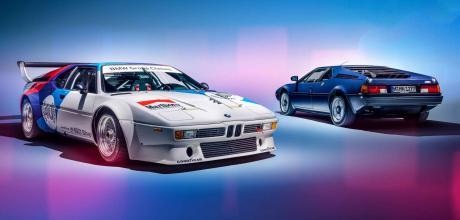1979-1981 BMW M1 E26
Step One of raising your profile as a car brand: build a supercar. And since you’re BMW Motorsport GmbH (the snappy one-letter nickname isn’t official until 1991), best make one that’s a racing car as well as a road car.
LEADING EDGE
Step Two: DM for collab. Giorgetto Giugiaro knows a thing or two about shaping supercars; Giampaolo Dallara knows how to develop them (he did the Miura, and one or two successful racing cars, after all); Lamborghini knows about building them.
The brief: Lambo to create the chassis, build the prototypes and, in turn, the production car. Giugiaro gets busy on the design, taking inspiration from Paul Bracq’s stunning 1972 BMW Turbo concept car. So far, so good.
But then, with a handful of prototypes racking up (fast) miles, Lamborghini hits financial difficulties. BMW transfers the build to Giugiaro’s Italdesign. It’s 1979 before the car’s launched and the complications have pushed the price to DM100,000. Sales are slow, even if the car isn’t (by 1979 standards, at least. With 274bhp of tuned, tuneful straight-six to push along 1300kg or so of spaceframe and fibreglass, it’s more brisk than supercar-fast today).
Enter Step Three: a little F1 marketing magic. M director Jochen Neerpasch convinces Bernie Ecclestone and Max Mosley that what F1 really needs is a one-make supercar support race, and the BMW Procar championship is born. The format is genius: the five quickest F1 drivers from Friday practice join series regulars to duke it out in widened, winged silhouette racers with power upped to around 460bhp (although outside of Procar, some M1 Group 5 racing cars boost to nearly 1000bhp). And fantastic period sponsor liveries: Marlboro, Denim, BASF cassettes… It runs for two seasons: Niki Lauda takes the first title, Nelson Piquet the second. The M1 was a remarkably well-resolved road car and an iconic racer. (Outside of Procar, it also raced at Le Mans and internationally, although with less success than M originally envisaged.) But a commercial success it was not. When production wrapped in 1981, 399 road cars had been made.
The M1 got M off to an iconic start but didn’t foreshadow what was to come – we’re still waiting for a successor. BMW’s head of design Domagoj Dukec: ‘People are always asking us about a new M1, and of course we’ve worked on that here very often; at least five or six times. You know what it’s like – you have a good year, there’s money and everybody thinks, “Yeah, it would be nice.” Or there’s a new development board saying, “Let’s do it!” So you create a really nice proposal, and you’re cool. Then, as you develop it, you come to a kind of crisis point. You look at it and think, should we really invest €400 or €500 million in such a car when we know we will never make money with it?’
Yes, Domagoj, absolutely you should.
M1 (E26)
M’s first road car, and its last supercar
- POWERTRAIN 3453cc 24v straight-six, five-speed manual, rear-wheel drive
- PERFORMANCE 274bhp @ 6500rpm, 243lb ft @ 5000rpm,
- 6.0sec 0-62mph,
- MAX SPEED 163mph
- LEGACY First a flop, now a legend
M1 PROCAR (E26)
If Carlsberg did one-make race series
- POWERTRAIN 3498cc 24v straight-six, five-speed manual, rear-wheel drive
- PERFORMANCE 463bhp @ 6500rpm, 288lb ft @ 5000rpm,
- 4.5sec 0-62mph (est),
- MAX SPEED 193mph
- LEGACY Only two seasons but it burned bright. Imagine Lewis and Max battling it out in M1s today


